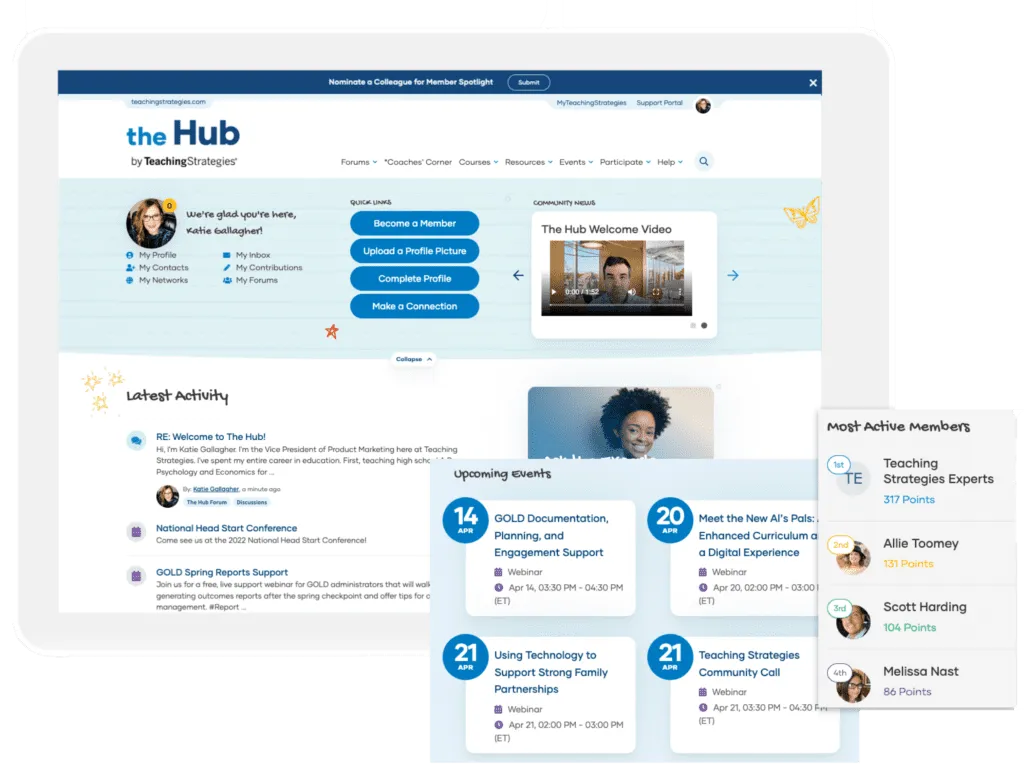7 Questions Teachers Can Ask to Seek and Offer Support

Teaching is tough. From guiding the learning and development of many unique young learners to tackling separation anxiety in children, teachers have many hats to wear. But there are people who have firsthand experience with the struggles teachers face and who can provide helpful suggestions to navigate challenging situations. Better yet, they’re people teachers see every day: fellow educators.
A recent post on The Hub, our online community of early childhood educators, showed that one of the most common ways teachers support each other is through conversation. If you’ve ever had a bad day, however, you know how quickly venting sessions can go from alleviating tension to making you feel more negative and drained.
To explore how teachers can prioritize their mental health and decompress with one another without falling into the trap of negative talk, we collaborated with Crystal Kuharski, a Teaching Strategies Hub Mentor and early childhood educator with over 20 years of experience.
Get Creative with Your Queries
Crystal’s first tip? Reframe classic questions like “How was your day?”—an innocent enough sentence that can unintentionally open a Pandora’s box of pent-up frustration—and get creative with your queries.
“If we ask a positive leading question, we have a better opportunity to receive a positive answer or solution,” she said, while emphasizing the importance of leaving room to air and address issues.
Keeping this in mind, here are seven conversation starters that can help you engage in productive, positive discourse that leaves you—and fellow teachers—feeling understood and motivated.
1. “What was the best part of your day?”
This positive question encourages teachers to open up while reflecting on their day.
“A teacher might answer, ‘We had so much fun playing in the sand today, but the cleanup was so difficult,’” Crystal said. “The positive is there—we always want to try to find the positive—but it’s also an opportunity to bring up tips on cleaning sand, for instance, and asking, ‘What works best in your classroom?’”
2. “What is the biggest difference you’ve noticed between this year and last?”
This question can provide a greater understanding of how the school or district is evolving and how your colleagues are responding to those changes. It can also encourage teachers to share what is working well and what needs improvement.
3. “Is there anything you’ve been working on that you’re particularly excited about or proud of?”
Aside from showing interest in a colleague’s work and supporting their efforts, this question can prompt educators to learn from each other.
4. “How do you handle challenging behavior from children?”
It can be easy to zero in on feelings of frustration, but asking a solution-based question like this one can encourage teachers to lean on one another while identifying ways to resolve specific problems.
5. “I saw the children in your class were really engaged in a discussion yesterday. What technique did you use to facilitate that?”
Sincere, personalized compliments like this one are excellent conversation starters that also allow teachers to explore the successes of other educators.
6. “I’m thinking of trying something new in my class. Do you have any experience or advice on the subject?”
Asking for advice shows you are open to feedback and support from your colleagues. This can foster a positive learning environment where teachers feel comfortable seeking advice and providing feedback to one another.
7. “Have you had any success with a particular classroom management technique? Would you be willing to share some tips?”
The benefits of asking this question are twofold. First, hearing how a particular technique has benefited a teacher can motivate you to try it yourself and strengthen your skillset. Second, this question encourages the teacher who answers to feel proud of the progress they’ve made and the effective techniques they have implemented in their classrooms.
A Tried-and-True Tip
Aside from asking thoughtful questions, Crystal encourages the use of a bulletin board to discuss important topics.
“We use index cards or sticky notes in green, yellow, and red to follow The Stoplight Approach,” she said. Red means a teacher needs immediate help with something, yellow signifies a request for advice or support, and green is reserved for positive suggestions and compliments.
Crystal began using this type of board when she joined a Head Start program that was spread out over three counties. Since this was before the age of Zoom and Slack, teachers in different counties found it challenging to consistently connect.
“We had a space where all of us would meet every week or so, and that’s where we put our board,” Crystal said. Having the option to be anonymous was especially helpful, she added. Mentors and coaches also had the opportunity to ask questions on behalf of the teachers they observed.
Go Forth and Flip the Script
Meaningful questions and establishing new ways to open up dialogue can enable teachers to foster a supportive work environment and deepen their ties with other educators.
As with anything, it’s important to be the change you wish to see. So, if you’ve noticed the teachers’ lounge teeming with negativity lately or that conversations with colleagues leave you feeling more drained than inspired, try using the tips above to flip the script for the better.

Talk with Teachers from Around the Country
Teachers with access to the Teaching Strategies platform can ask questions and join in conversations with other educators in The Hub.


